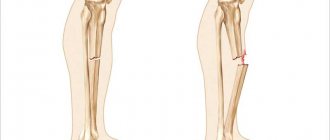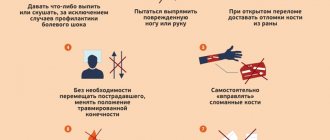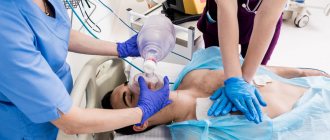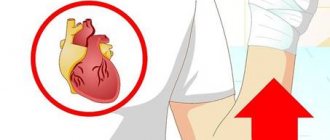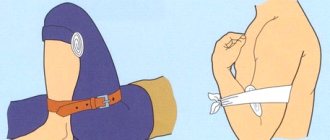During accidents, emergencies and natural disasters, people get injured. Most often these are fractures, which are accompanied by blood loss and painful shock. The success of further treatment largely depends on how timely and correctly first aid was provided for open and closed fractures.
Guidelines and a poster about fractures on the stand are available after the article.
General classification of fractures and their characteristic features
The general classification of fractures is usually based on the degree of rupture (damage) to the bone. First of all, a distinction is made between complete and incomplete fractures, as well as open and closed, with and without displacement of bone fragments. It wouldn’t hurt to immediately voice the general signs on the basis of which a person is preliminarily diagnosed with a fracture:
- an arm, leg, spine or pelvis is deformed;
- severe pain in the damaged area;
- the position of the limb looks unnatural;
- hemorrhages and swelling are observed.
The main actions in such a situation are, if possible, to restore the integrity of the bone, stop the bleeding, if any, treat the wound with an antiseptic, immobilize the damaged limb and transport the patient to the trauma department of the hospital on an emergency basis.
Main types of fractures
Most often, fractures are divided into closed and open. In the first case, the skin is not damaged, in the second, the skin is torn, and parts of the bone can protrude beyond the wound. With an open fracture, tissue infection occurs, which means recovery takes longer.
Based on the nature of damage to bones and adjacent tissues, the following types of fractures are distinguished:
- comminuted - the bone is destroyed with the formation of many fragments;
- complicated – nerve fibers and internal organs are affected along with the bone;
- displaced – bone fragments are displaced relative to each other;
The fracture can also be partial in the form of a crack. This violation of bone integrity is more common in children due to the elasticity of bone tissue.
Principles of providing first aid
With the help of first aid, you can significantly reduce the risk of complications - infection, painful shock, displacement of fragments. The principles of action are similar for open and closed fractures, but there are some nuances that you need to become familiar with.
First aid for broken limbs
Let's consider the algorithm of actions and rules of first aid for a broken limb:
- Look around and make sure there is no danger to yourself and the victim.
- If a person is without signs of life, take resuscitation measures and only then provide assistance for a fracture.
- Call the emergency services team.
- If there is arterial bleeding, take measures to stop it.
- Try not to change the position of the victim’s body and limbs, especially if a spinal fracture is suspected. If you need to remove clothes or shoes, do it carefully, starting with a healthy limb.
- Take measures to prevent painful shock.
- Provide immobilization.
Until the ambulance arrives, you need to stay next to the victim, monitor breathing, pulse and consciousness, and also try to calm him down.
Additionally read:
Types of external bleeding and first aid
If the fracture is open, you need to carefully, without changing the position of the injured limb, stop the bleeding by choosing the most appropriate method. The area of skin around the wound should be treated with an antiseptic solution, then a clean bandage should be applied. After this, you can prepare a splint that must match the length and fix the injured limb. Until the ambulance arrives, the victim must be kept at rest. If the collarbone is fractured, you need to put a roller in the armpit, bend your arm at the elbow, hang it on a scarf and bandage it to the body.
Prevention of painful shock
Due to damage to soft tissues and nerve fibers, severe pain occurs during a fracture. If you do not provide assistance in this direction, traumatic shock may begin, which is life-threatening.
To avoid this condition, you need to:
- give the victim 3-4 tablets of analgin or 1-2 tramadol (or another painkiller);
- apply a cold compress to the injury site - ice, snow, etc.
The development of painful shock is facilitated by general cooling of the body, so during the cold season the victim must be covered. Immobilization also helps prevent shock.
Arm fractures: what should be done and what should not be done?
The most important point is to immobilize the broken limb as quickly as possible so that a closed fracture does not become an open one. To immobilize the arms, it is customary to use splints, fixing them to the limb in a certain way. If a real tire is not at hand, you can use improvised materials - for example, a thick tree branch, plywood, boards, etc. In case of severe pain, the victim should be given a painkiller. The arm with the splint should be bent at the elbow and suspended, and in order to prevent the development of pain shock, the patient is warmed in all possible ways, from hot tea to blankets or heating pads.
If the patient has an open fracture, the main task is to stop the bleeding by applying a tourniquet above the wound surface. The time for applying a tourniquet should be no more than 30, maximum 40 minutes, otherwise necrosis of the limb may develop, since it practically does not receive blood flow. If there is no tourniquet nearby, any available means in the form of a piece of torn fabric, rope, or belt will do instead.
To prevent infection, the wound is treated with an antiseptic. It is unacceptable to pull the patient’s injured limb in an attempt to straighten the bone.
Stages of treatment of open fractures in the Medicenter clinic network
Immediately after an open fracture, the main danger for the patient is pain shock and blood loss, so first of all we administer painkillers and correct the patient’s general condition.
Next, you need to determine the severity of the damage. In order to establish the location of bone fragments, patients need an x-ray examination. The X-ray room at the Medical Center is open from 09:00 to 21:00.
Then we perform surgical treatment of the wound. We thoroughly rinse with an antiseptic solution and remove necrotic tissue. It is optimal if this is done in the first hours after injury, so we emphasize once again that it is very important to immediately take the patient to the clinic. If there is suspicion of damage to nerve endings and blood vessels, we call our consultants in the field of neurosurgery and vascular surgery. Given the risks of infection, our surgeons may recommend not suturing the wound immediately. It is left open so that regular processing and monitoring of its condition can be carried out. If the first signs of infection appear, we immediately begin the entire range of measures aimed at treating the wound infection.
The next stage is the direct healing of the fractures. Since the initial contamination of the wound prevents immediate reduction (comparison of bone fragments) and osteosynthesis (operations for fusion of bones using metal structures), we treat such fractures using skeletal traction, open orthrodesis (such as a plaster or polymer bandage) or compression-distraction devices.
The final stage of treatment is rehabilitation. For rehabilitation, we use an integrated approach, including physical therapy, physiotherapy and massage.
Leg fractures: what should be done, what actions are unacceptable?
Fractures of the lower extremities are accompanied by:
- impairment of their mobility;
- acute pain;
- open bleeding (if large arteries are damaged as a result of an open fracture);
- closed bleeding (inside the tissues, if we are talking about a closed fracture).
Nerves may also be affected, causing the limb to lose its former sensitivity.
The first thing to do when a leg is broken is to fix it using available means (board, long tree branch, ski pole). As in the case of a fracture of the upper limb, if it is open and accompanied by severe bleeding, a tourniquet is applied to the leg above the affected area. For severe pain, the patient is given analgesics.
If possible, the limb is immobilized using a Dieterichs splint. These are boards with drilled holes. By connecting them together, you can completely immobilize your leg.
Self-reduction of the bone at the scene of the accident is unacceptable.
What can and cannot be done for spinal fractures
This is one of the most severe and complex types of fracture, threatening the patient’s life. First aid must be provided competently and correctly, with the body held still and painkillers taken. Even if the damage to the spine, at first glance, looks insignificant, it can lead to disability of the victim. In such cases, people's ability to move is often completely or partially lost.
Why is such a fracture dangerous? First of all, damage to the spinal cord from bone fragments. If fragments of broken bones touch nerve fibers or blood vessels, this can lead to complete loss of both sensory and motor functions.
Symptoms for spinal column fractures usually look like this:
- the fracture area is very painful;
- the patient often loses consciousness and his blood pressure drops;
- if the cervical spine is broken, the head takes an unnatural position, and breathing functions are severely impaired. Unfortunately, in the vast majority of cases, people do not survive such a fracture, and death occurs instantly;
- if the lower back is injured, the legs cannot move. Involuntary urination often occurs.
Anesthesia and immobilization are the first things to do if the victim has signs of a spinal fracture. It is advisable for the patient to be on a hard, horizontal surface. For the purpose of immobilization, available means in the form of a board, door or large sheet of plywood are suitable. The head is fixed with a rigid “collar”, using soft cloth or cotton wool, if available.
Realignment of the spine is unacceptable, as are attempts to sit the victim down and, moreover, put him on his feet.
What can and cannot be done for pelvic bone fractures
Like spinal fractures, injuries to the pelvic bones are classified as severe clinical cases. There are a lot of complications with them: disability, internal bleeding with a state of shock.
Typical symptoms of pelvic fractures include:
- severe pain in the bones, groin, stomach;
- bruises are found in the perineal area;
- an external examination often reveals deformation of the pelvic bones;
- if severe bleeding occurs, the pressure drops sharply, and a state of shock develops;
- The patient’s posture is forced, reminiscent of the position of the body of a frog: the knees are bent.
The basic principles of first aid are immobilization in the same position with fixation of the pelvic bones using any dressings, including improvised ones. A cushion is placed under the bent knees. It is strictly prohibited to put the victim on his feet or sit him down.
Immobilization rules
Immobilization is a set of measures aimed at ensuring the immobility of the injured limb. For this, various tires are used, including those made from handy materials - sticks, boards, rods, etc.
Splinting rules
When applying a splint, you must follow a number of rules:
- It needs to be applied as early as possible. The fracture is accompanied by swelling, which will not allow splinting to be carried out correctly.
- The splint is applied after pain relief, and not vice versa.
- The object is applied on both sides of the damaged limb, fixed with a bandage along the entire length, except for the fracture site.
- If the femur is fractured, a splint is applied from the armpit to the foot.
- If the fracture is open, first treat the wound, apply a sterile or clean bandage, and only then begin splinting.
- The bleeding must be stopped before a splint is applied. If a tourniquet was used, a splint is applied so that it can be removed without disturbing immobilization.
- The arm is suspended in a sling; if a leg is broken, something soft is placed under it.
- In the cold season, the injured limb is wrapped in a warm cloth.
- To control blood circulation, the first phalanges of the fingers are left open.
When transporting a victim to a medical facility, it is necessary to ensure the correct position of the body. If the legs are broken, the patient is transported in the “lying” position, placing a soft cushion under the injured limb. If an arm is broken, transportation while sitting is allowed.
Additionally read:
